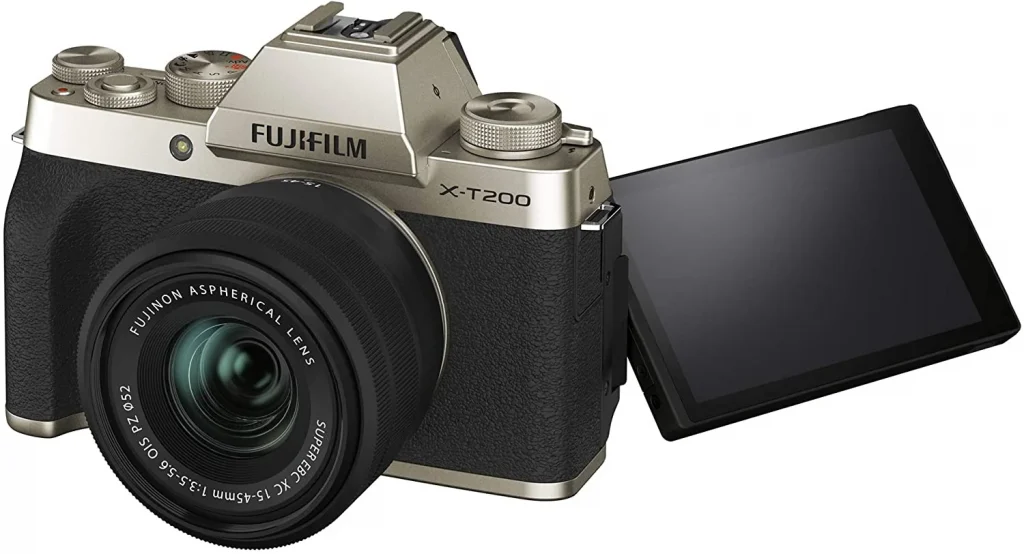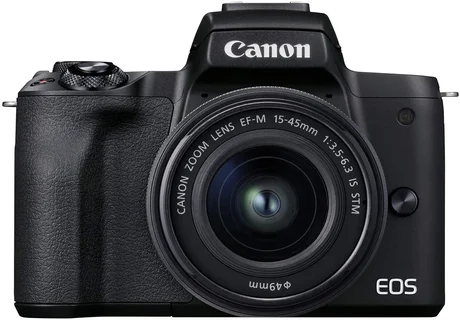Fujifilm X-T200 mirrorless camera review
Fujifilm X-T200 Less than two years have passed since the amateur Fujifilm X-T100 model was announced, and the manufacturer announced its update, which will be devoted to this material.
The new Fujifilm X-T200 is an excellent choice for those who lack the capabilities of the more affordable Fujifilm X-A7 camera, for example, due to the latter’s lack of a viewfinder. Unlike its direct predecessor, the Fujifilm X-T100, the heroine of our review, has a more advanced version of electronic image stabilization when shooting video called the “Digital Gimbal Function.” In addition, the novelty has a display with mobility in all planes, improved phase detection autofocus, and some other advantages.

Fujifilm X-T200 mirrorless camera
| Name | Fujifilm X-T200 |
| Date of announcement | January 23, 2020 |
| Type of | system mirrorless camera |
| Camera Information | Fujifilm X-T200 on the manufacturer’s website |
The main thing
- 24MP APS-C CMOS sensor (6000 × 4000)
- Hybrid autofocus (AF) with 425 phase sensors
- Face and eye detection function for autofocus
- Equivalent sensitivity to ISO 200-12800 (extendable to ISO 100-51200)
- Burst speed up to 8fps (buffer capacity 20fps)
- Video recording in maximum UHD 4K resolution (3840×2160) @ 30fps
- Electronic Picture stabilization when shooting film
- Display with touchscreen, movable in all planes
- Built-in flash with guide number 7 (in meters, at ISO 200)
- Supports SD / SDHC / SDXC memory cards (UHS-I)
- Wi-Fi + Bluetooth 4.2
- USB 3.1 Gen1 (Type-C)
- Battery capacity up to 270 shots in standard mode (or up to 450 shots in economy mode)
- They are introducing the specifications of the new camera ( according to the manufacturer )
Fujifilm X-T200 Specifications
| Model | Fujifilm X-T200 |
| Bayonet | Fujifilm X |
| Sensor | CMOS (CMOS), APS-C, 23.5 x 15.7 mm |
| Sensor resolution | 24.2 million effective pixels 1 |
| Still, the picture recording format | Still image resolution & Video recording resolution, and duration |
| anti-aliasing, portrait, streaks of light, multiple exposures, text, flower, party, underwater, beach, snow, sunset, fireworks, night (tripod) | JPEG (Exif v2.3); RAW (RAF) |
| Autofocus (AF) | hybrid, phase, and contrast; 425 zones |
| AF areas | point, zone, wide area |
| Focus modes | single frame, continuous, manual |
| Autoexponometry (AE) | 256-zone TTL; multi-segment, point, average |
| Exposure modes | SR + (Auto Scene Selection), P (Program), S (Shutter Priority), A (Aperture Priority), M (Manual), Panorama, Night Scene, Sports, Landscape, Portrait, SP (Scene Selection), Adv. (advanced filters) |
| Exposure compensation | photo: ± 5 EV in ⅓ steps; video: ± 2 EV in steps of ⅓ |
| Equivalent sensitivity | mechanical shutter: “P” – 4-1 / 4000 s, other modes – 30-1 / 4000 s, Bulb – up to 60 minutes; electronic shutter: “P” – 4-1 / 32000 s, other modes – 30-1 / 32000; mechanical + electronic shutter: “P” – 4-1 / 32000 s, other modes – 30-1 / 32000 s, Bulb – up to 60 minutes |
| Gate | focal plane vertical course, electronically controlled |
| Exposure ranges in different shooting modes | guide number 2 – 7; modes: auto, fill, slow sync, command, off; rear-curtain sync, red-eye removal |
| Built-in flash | H mode: 8 frames / s (about 20); L mode : 3 frames / s (about 50) |
| X-sync shutter speed | 1/180 s |
| Self-timer | 2 s, 10 s |
| Rate of fire (buffer capacity) | anti-aliasing, portrait, streaks of light, multiple exposures, text, flower, party, underwater, beach, snow, sunset, fireworks, night (tripod) |
| Artistic effects | L mode : 3 frames / s (about 50) |
| Scene presets | anti-aliasing, portrait, streaks of light, multiple exposure, text, flower, party, underwater, beach, snow, sunset, fireworks, night (tripod) |
| Film Simulation Mode | Provia / Standard, Velvia / Vivid, Astia / Soft, Classic Chrome, Pro Neg.Hi, Pro Neg.Std, Monochrome, Monochrome + Ye Filter, Monochrome + R Filter, Monochrome + G Filter, Sepia |
| Display | 3.5 ″ TFT 2.76 Mp, touch, movable in all planes |
| Viewfinder | electronic (OLED) 2.36 Mp; magnification 0.62 × 3 ; viewing angle 30 ° diagonally; eyepiece extension by 17.5 mm; refraction correction adjustment from -4 to +2 diopters |
| Interfaces | USB 3.1 Gen1 (Type-C), HDMI (Type-D), mic-in, hot shoe (ISO 518) |
| Wireless connection | Wi-Fi (IEEE 802 / 11b / g / n), Bluetooth 4.2 BLE |
| Memory cards | one slot for SD / SDHC / SDXC (UHS-I) |
| Battery | Li-ion battery NP-W126S; 1260 mAh; up to 270 frames in standard or up to 450 frames in economy mode or up to 55 minutes of video in 4K 30p (CIPA method) |
| Dimensions (edit) | 121 x 84 x 55 mm |
| Weight (with battery and memory card) | 370 g |
Design and construction
Like its predecessor, the X-T100, the Fujifilm X-T200 looks like a standard camera with a metal cover on the top and a textured finish all over the body. The viewfinder is right in the middle, while the device’s dimensions are 12.1 × 8.4 × 5.5 cm. The camera fits easily in hand, and at 370 grams (including battery and SD card), it is 80 gr lighter than the Fuji X-T100.
LCD

A 3.5-inch, 2.76M-dot LCD touchscreen dominates the X-T200’s rear surface. The display is mounted on a hinge on the left, which allows it to be rotated 180 degrees forward for frontal shooting. The screen also rotates on a horizontal axis from 0 to 270 degrees. All movements are smooth, and the panel is securely in place. It is surprising how bright it is – even on the street, everything is legible, only in the sunlight I had to strain my eyes a little.
To the LCD’s right are two buttons with two functions. The top one opens a menu or selects the current option on the screen. The lower one switches between different shooting modes and performs a “back” action when navigating the menu. Situated just above these keys is a tiny joystick that replaces the traditional four-way button for navigating the screen and interface and allows you to adjust focus while shooting quickly. The joystick doesn’t feel redundant because it has comfortable feedback, although many users will find it too small for their fingers.
Main Display

Above the screen in the middle, there is a viewfinder with flash and a hot shoe on top. The shutter and video buttons are slightly to the right. Unfortunately, the key for activating video recording is also too small. It gives almost no feedback – when preparing to start shooting, you often have to check whether your finger is in the right place.

Buttons
Like most Fujifilm cameras, the X-T200 has many buttons and dials that can initially be confusing. Each has several functions, so remembering them all at once is difficult.
The shutter release button is surrounded by a ring that can adjust both aperture and shutter speed, or even aperture and shutter speed simultaneously, depending on which mode is on.
Behind the button to start recording video is another setting dial. When the menu opens, you can navigate between tabs and screens and adjust the exposure compensation during shooting. The 0.39-inch 2.368 million-dot OLED viewfinder is also very responsive. It has 0.62x magnification and a higher refresh rate than the X-T100. The exposure compensation value is displayed on its left side.
There is a 3.5mm microphone jack for professional video shooting or blogging. Headphones can be connected via USB using the included adapter. If you use a tripod, the location of the memory card slot and battery on the underside will probably be inconvenient—you must disconnect the camera from the tripod to access it.
Convenience and autofocus
In terms of convenience, the Fujifilm X-T200 camera surpasses its predecessor in many respects due to the more powerful processor and the Bayer filter used. Among the improvements are also increased photo shooting speed (8 fps versus 6 fps for the X-T100), higher video quality (4K / 30 fps versus 4K / 15 fps), and the same fast autofocus (in the X-T100 is the best among Fujifilm mirrorless cameras)
The X-T200’s autofocus covers 100% of the frame with 425 focus points, while the T100 has 25% and only 91 points. Like the top models in the Fuji X-T3 and Fuji X-T4 line, the T200 features Hybrid Phase and Contrast AF, taking the best of both technologies. The first quickly finds the desired object, while the second uses small details of the scenes for more precise adjustment. With high sensor speed and processor bandwidth, it uses both systems simultaneously for the best results.
Interface and control
If you are not a professional photographer and just want to shoot what you enjoy, the Fujifilm X-T200 is perfect. Especially considering the many interesting presets and filters. However, the more settings you make, the more difficult it becomes to operate the camera.
After a while, you will get confused by the numerous screens, menus, control dials, and buttons. Moreover, one setting can override or restrict another, even if they seem unrelated at first glance.
Nevertheless, Fujifilm has tried to create an intuitive interface controlled by swipes and taps on the screen. Turning the tuning dials is often not necessary, and some menus are not necessary at all. Many icons on the screen may seem confusing initially, but the question mark in the lower-left corner will give you a clear hint.
A particularly convenient element of the X-T200 interface is the split into two parts, the “before” and “after” screen—it instantly displays the result of applying any filter (including Velvia, Astia, Classic Chrome, etc.). You can also turn on the Advanced Filters set through the mode dial, which already has 20 filters.
function
The functionality of the touchscreen often seems limited. All presets for a scene are available only in program mode, and you can change the exposure in it only through the exposure compensation (EV) setting. But, the screen with the EV change (where the value changes in 1/3 steps by swiping up and down) does not show the value itself (2 or 3). To control the settings completely, click the Q icon to open options such as filters, ISO, noise reduction, dynamic range, timer, and flash.
Nevertheless, in Settings, all menus are located intuitively, and navigation through them is convenient. However, there are limitations here: some items will be inactive depending on which mode is enabled on the corresponding control dial. Sometimes, the quickest way to set the desired value is to reset it to factory defaults rather than searching through numerous screens and options.
Application and software
The Fujifilm X-T200 has an excellent Fujifilm Remote Camera app for Android or iOS. Through it, you can remotely shoot a photo or video and make many settings like ISO and EV. In addition, the application allows you to download the selected files to your smartphone or immediately transfer them to it after shooting.
Fujifilm’s RAW File Converter software is available for download immediately after purchasing the camera. It is not as functional as Adobe Lightroom and only works with RAW files. There are plenty of opportunities here, but many necessary functions, such as access to metadata, are lacking.
After purchasing the X-T200, you can download Capture One Express for free for more photo enhancement options. Capture One Express is based on Phase One Capture One, is an alternative to Lightroom, and is used by many professionals to process high-quality RAW files.
If you connect your Fujifilm camera to your computer, you have more features than the Remote app. In addition, Capture One Express works with photos and videos.
Fujifilm X-T200 Photo quality

The Fujifilm X-T200 is designed primarily for beginners to take excellent-quality photos even with standard settings.
When shooting in daylight, colors are expected to be vibrant and accurate, with incredible detail. Focusing is excellent when optical image stabilization eliminates blur without a tripod.
The face/eye tracking is fast and accurate, so the X-T200 quickly focuses on the right person. However, the camera does not always adequately expose complex scenes with large objects such as leaves and branches, and the picture comes out too bright.
According to Fuji, the X-T200 can shoot at night without noise and has high photo quality. There are many details in any area when there is no noise, even in the shadows.
Shooting speed
The table shows the average shooting speed for different modes. Let’s call the first speed the one with which the burst shooting starts. Its limit is the time after which shooting slows down and continues at a second speed. Units of measurement are frames per second and seconds, respectively. The infinity symbol means the speed has not changed throughout a hundred frames.
| Mode | First speed | First speed limit | Second speed |
| JPEG Low | 4.0 fps | 9.0 s | 2.0 fps |
| JPEG High | 8.3 fps | 3.6 s | 4.0 fps |
| RAW Low | 4.0 fps | 5.8 s | 1.7 fps |
| RAW High | 8.3 fps | 2.2 s | 1.7 fps |
Fujifilm X-T200 video quality
The new X-T200 can capture 4K video at 30 fps. Colors and exposure are excellent, although focus doesn’t always work reliably.
The equipment is well suited for blogging because the LCD screen swings forward. Since the model will be bought mostly by non-professional photographers, she must be good at shooting in natural light and dark conditions. However, the X-T200 is not always perfect – the resulting videos are a little dark when the colors are oversaturated.
You need to set the exposure compensation yourself to get the best results. Face AF does a good job here, so you’ll stay in focus even if you actively move around the frame. The sound I recorded was clear and loud.
Fujifilm Feature
A recent update has added features for using the Fujifilm X-T200 as a webcam. For example, when connected to a computer via USB, you can adjust the exposure compensation via the disk (not via the screen since it is disabled). Depending on the lens attached, you can adjust the scene depth to blur or sharpen the background.
There are also three stabilization methods for video, each eliminating the need for a tripod. The first is optical image stabilization built into Fujifilm lenses. It gives the best results of all three. The other two are digital and perform slightly worse. Although it uses gyroscopic sensors in the device’s body, the new Digital Gimbal stabilization system still crops the frame up to 2x. The Digital Image method does not use sensors when the photo is cropped to 1.1x.
HDR also appeared in the X-T200 for video recording. As with stills, HDR for video works digitally rather than combining three shots at different exposure settings into one. As a result, the color range with HDR is only slightly wider than without it.
Outcome
The Fujifilm X-T200 is a great beginner’s camera, capable of capturing great-quality photos and videos. It has fast autofocus, above-average video resolution, and more features than the previous model. The new camera is also tiny and lightweight, so you can take it anywhere.
If you’re not going to make many adjustments before shooting, the X-T200, with its handy icons on the swivel touchscreen and a selection of quality filters, is perfect. However, there are many menus, buttons, screens, and dials to create more professional photos.
Fujifilm X-T200 review – video
Advantages and disadvantages
| Advantage | Disadvantage |
| Responsiveness in work | Unreliable video tracking |
| Excellent quality photo | Many incomprehensible screens, menus, and buttons |
| Good video quality for blocks | – |
| Easy to use touch screen | – |
| Responsiveness in work | – |
| Excellent quality photo | – |
Fujifilm X-T200 Competitor Competitors
Choosing rivals worthy of comparison with today’s heroine, we were guided primarily by the image sensor’s characteristics, the ability to use interchangeable lenses in conjunction with cameras, the presence of an electronic viewfinder, and the price and marketing positioning of the models. The APS-C frame size, the exact sensor resolution (24 megapixels), and the focus on hobbyists unite the cameras shown in the table below. We did not include models with sensors of a different size (1 “and MFT) and APS-C SLRs in the group of competitors since they are all products of entirely different categories.
Compare
The cameras are not very similar in appearance, but the photos do not differ in resolution. You can easily see that the Sony α6100 is ahead in terms of rate of fire and ISO operating range. However, the price that has to be paid for all these advantages can hardly be considered affordable for the amateur photographer.
The other extreme is a competitor from the Canon camp. This camera is the most modest in its capabilities. Its advantages compared to competitors are limited to the fastest X-sync speed (1/200 s), the most negligible weight (299 g), and dimensions.
Our ward looks very good in the comparison group: she has the largest (3.5 ″) and the most mobile display with the highest resolution (2.78 megapixels). At the same time, it is significantly more expensive than the Canon EOS M50 but more affordable than the Sony α6100. For video shooting, especially in the practice of a vlogger, the Fujifilm X-T200 seems to be the most successful option.
Read More Reviews
FUJIFILM X-S10 live-action review
FUJIFILM X-Pro3 live-action review.
The FUJIFILM X-T30 Review Good points and bad points
Recommended best birding camera For photography
Top 10 Best affordable camera for wildlife photography

















